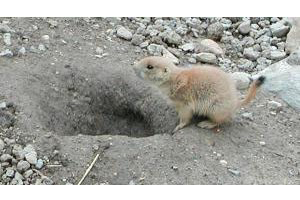Black-tailed prairie dogs live in small groups of one or two males, two or three breeding females, several nonbreeding juveniles, and pups born that year. A few to thousands of these groups, called coteries, make up a prairie dog town. Towns are a building block of prairie ecology. They provide habitat for mountain plovers, harvester ants, black-footed ferrets, burrowing owls, and many other species. Prairie dogs are food for ferrets, ferruginous hawks, and prairie rattlesnakes.
Photo Credit: Tanya Dewey
Cynomys ludovicianus
Common Name: black-tailed prairie dog
Other Common Names: sod poodle
Animal Guild: Mammal
Class > Order > Family: Mammalia > Rodentia > Sciuridae
What does the species look like?
The back is orange-brown with white flecks. The belly and sides are pale to deep orange. Head and body length is about 13 inches (28-34 cm); the tail is about 3 inches (6-9 cm) long. Black-tailed prairie dogs are substantially larger than any ground squirrel, and their black-tipped tail distinguishes them from other prairie dog species occurring in the United States.
Where is the species found?
States & Provinces
AZ, CO, KS, MT, ND, NE, NM, OK, SD, SK, TX, WY
Distribution
The range extends through much of the western Great Plains, in the short and mixed grass prairies from southwest Saskatchewan to the northeast corner of Sonora and northern Chihuahua, Mexico.
The black-tailed prairie dog prefers dry, level or gently sloping habitats in open areas to increase visibility of predators and possibly reduce risk of flooding. There may be some shrub and tree cover in marginal habitat, but woody cover is minimal in preferred habitat. Short grass and mixed grass prairies are preferred. Tallgrass prairie habitat is used if vegetation height is reduced by heavy grazing, mowing, or other disturbance. Once a town is established, the plant community within the town is modified by constant clipping of taller vegetation. Soils must support burrowing so medium texture soil is preferred and sandy or rocky soils are avoided.
General Phenology and Life History
Prairie dogs mate between January and April depending on latitude and elevation. One to 10 (average about 5) young are born after a gestation period of 33 to 38 days (in March or April in Colorado and Texas). Pups emerge five to seven weeks after birth (in May or early June in Colorado and Texas). By August or September, the young are about 2/3 the size of an adult, and by late fall they weigh almost as much as the adults. Males disperse as yearlings. Some females disperse but others stay in their natal coterie. Black-tailed prairie dogs do not hibernate. They are active on warm days throughout the winter.
Which phenophases should I observe?
Do you see/hear...?
Activity
Live individuals More...
For abundance, enter the number of individual animals observed in this phenophase.
Feeding For abundance, enter the number of individual animals observed in this phenophase.
Development
Young individuals For abundance, enter the number of individual animals observed in this phenophase.
Dead individuals For abundance, enter the number of individual animals observed in this phenophase.
What do these phenophases look like?
There is currently no photoguide available for this species. If you'd like help us create one, use the guidance document and species template provided here . Then send it via email to education@usanpn.org when it is complete.
